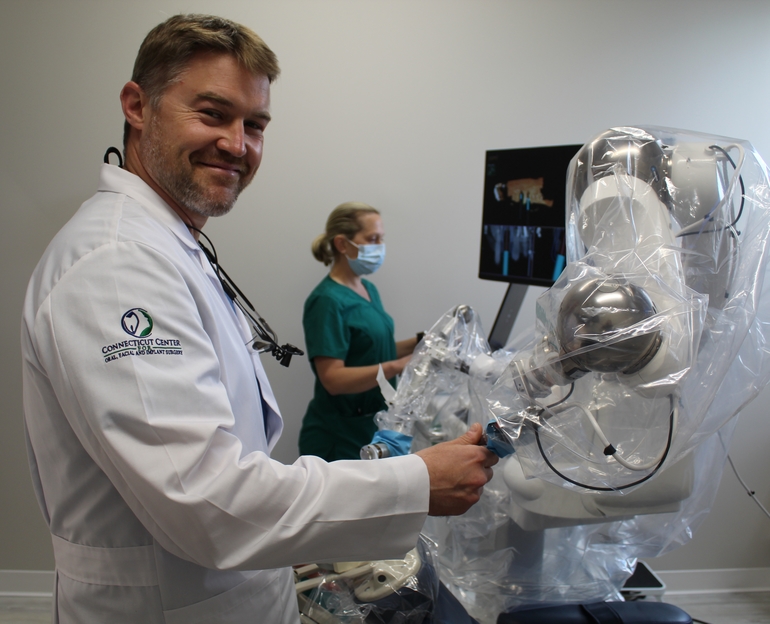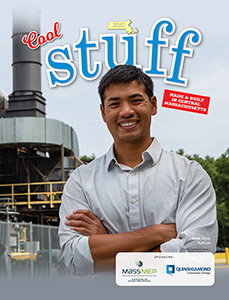With a tiny haptic vibration similar to a phone notification, the robotic arm locks into place. Guided millimeter by millimeter with 3D scanning, the robot is now ready to drill into bone at a precise angle and depth optimal for a dental implant, or replacement tooth anchored into the jaw.
“With this you know exactly where you are,” said Dr. Jacob Gady of West Hartford’s Connecticut Center for Oral, Facial and Implant Surgery. “It’s accurate, predictable and minimally invasive, and fast,” he said of the guided robotic system, called Yomi.
Gady’s practice at 80 S. Main St. is one of only about 60 nationwide currently using the Yomi system, the latest in a series of innovations that have made dentistry a proving ground for new technologies, materials and techniques. Patients seeking removal of wisdom teeth or dental implants can now benefit from 3D printing, image-guided surgery techniques and super-durable materials. Those dreaded dental procedures are also shorter and less invasive.
“Instead of grafting and modifying tissue, the goal is being able to work with what structure is there,” Gady said of robotic-assisted surgery.
A procedure that kept a patient in the dental chair for about 30 minutes with prior technologies now can take as little as 6 minutes, he said. The surgery is planned down to the millimeter beforehand using CT scanning, and the robotic arm can perform the drilling without the readjustment needed when a surgeon is operating “freehand.”
Gady’s background in electrical engineering drew him to robotic technology, he said. He graduated from the UConn School of Dentistry in 2009 and completed his oral and maxillofacial surgery residency in 2015, also at UConn.
Respected West Hartford dentist Dr. Judd Fink hired Gady to join his practice in 2015; upon Fink’s retirement in 2017, Gady took charge and hired Dr. Emily King to join him in 2020. Now in the process of more than doubling the practice’s footprint on South Main, Gady is looking ahead to expanding the use of robotic technology for his growing implant business.
“It’s more for patient comfort,” Gady said of his use of the Yomi system, which he acquired in Jan. 2020. After a period of training — followed by a month-long closure due to the COVID-19 pandemic — the robotic system has become a main focus of his practice, with more than a hundred procedures performed in the last year.
“Now with robotics, the workflow is very efficient,” Gady said.
Technology meets challenges
Dentists across Connecticut are increasingly incorporating technology into their practices like 3D printing to shape crowns and bridges, said Dr. Annemarie DeLessio-Matta, president of the Connecticut State Dental Association.
But the technology making the most impact in the last year has been “teledentistry,” the use of phone and video platforms to diagnose and screen patients with tooth problems. Almost unheard-of before the pandemic, teledentistry was included in Gov. Ned Lamont’s expansion of telemedicine last year.
DeLessio-Matta said she now routinely uses forms of teledentistry in her Southbury pediatric dentistry practice, with patients sending video and photos of ailments like ulcers and cavities to her for preliminary diagnostic purposes.
“We can screen them … we can diagnose most things,” DeLessio-Matta said, adding that the technology benefits both doctor and patient. “I know what’s coming in the door … that makes it easier for the patient. They can get an answer right away, it saves time.”
Other pandemic impacts, however, are challenging the dental industry’s finances, DeLessio-Matta said. Dentists had to scramble and pay premium prices to get personal protective equipment like masks and shields early in the pandemic and now face increased costs for reconfiguring their practices to minimize virus risk.
At her practice, DeLessio-Matta has installed glass shields through her treatment spaces. To allow aerosols to settle, patient appointments must be spaced farther apart, leading to lower volume. Gady has expanded into an adjacent space in part to allow for larger treatment rooms and safer patient spaces, he said.
The added pandemic-related costs have strained the budgets of many dental practices, DeLessio-Matta said, leading to early retirements and closings. It may also hasten industry consolidation, with corporate “dental service organizations,” or DSOs, making new inroads in an industry long-known for its independent practices.
DSOs like Aspen Dental and Heartland Dental are projected to make up nearly 50% of the dental market by 2030, according to industry publication DentistryIQ. Illinois-based Heartland has affiliated practices in Glastonbury and Oxford and Aspen clinics operate in 10 Connecticut locations, including Bristol, Farmington and Glastonbury.
The trend of dentists selling to or working for DSOs is likely to accelerate due to the pandemic, DeLessio-Matta said.
Expense limits adoption
As an added expense, robotic surgery systems like Yomi — which require an initial investment of $150,000 plus per-case fees that can total up to $30,000 a year — are unlikely to find widespread use in Connecticut dentistry until the cost comes down, said Dr. Avinash Bidra, a clinical professor and director of the prosthodontics (tooth replacement) program at UConn’s School of Dental Medicine.
“It is very helpful for very complex surgeries, but ultimately someone has to pay for it,” Bidra said.
However, other helpful technologies like in-mouth cameras that were once prohibitively expensive and rare are now commonly found in dental practices, Bidra added, and the same could one day happen with robotic systems.
For now, navigated surgery using CT scanning has been more widely adopted and allows dentists to operate freehand with much more accuracy.
For Gady, the precision of robotic surgery allows him to offer patients same-day removal and replacement and smaller, lighter dental implants. Patients can also get an entire “arch” or set of teeth replaced in one procedure.
“This will change things,” Gady said of the robotic technology. “It’s just much faster and much more accurate.”



